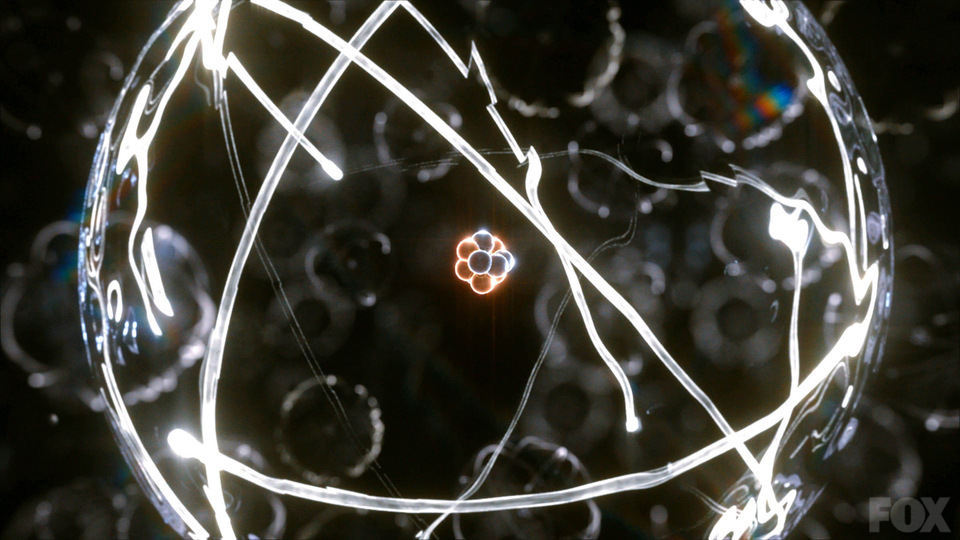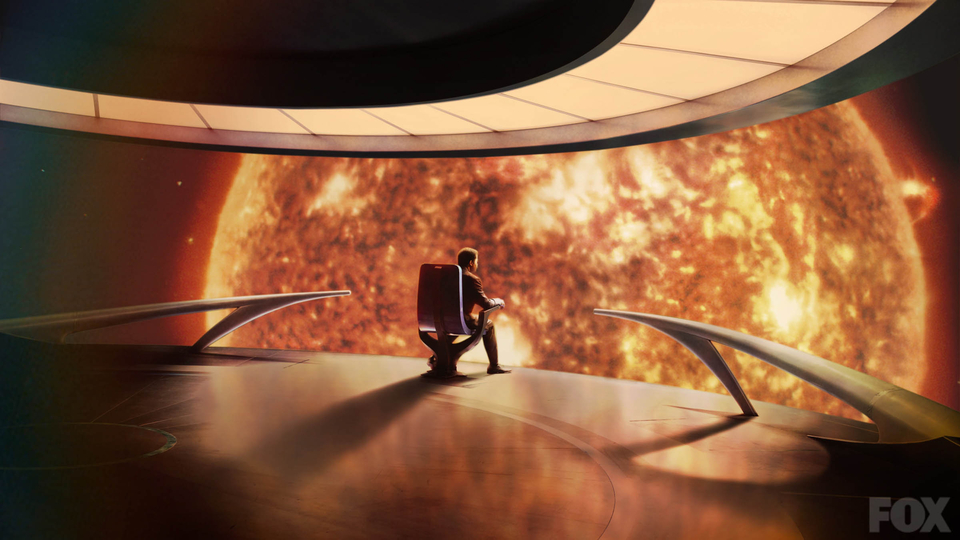 |
| This week takes us from the farthest we can see in the universe to the tiny heart of an atom. (cosmosontv.com) |
If you thought that was cool, come deeper still and let's get down to nitpicks.
Nitpicks
 |
| "I know a place where atoms actually touch each other." (cosmosontv.com) |
Oh, so close, Dr. Tyson! It turns out that even in the impossibly hot core of the Sun, where the average speed of a proton is somewhere around 400 kilometers per second in a gas with a density 150 times that of liquid water, protons only very rarely have enough energy to overcome the incredible repulsion between their like-charges. Think of pushing two very strong magnets together: The force between them grows very quickly as they get close. In the case of two protons, they have to come incredibly close to one another in order for the strong nuclear force (which binds atomic nuclei together) to become relevant, and the force between them becomes immense. The force between two protons at the distance that the strong force begins to become important (about 10^-15 meters, or a millionth of a billionth of a meter) is about 230 Newtons, or about 50 pounds. That may not sound like very much, but you have to remember that a proton weighs about a billionth of a billionth of a billionth of a kilogram (or a pound). If you think about that in human terms, it's like trying to hold the weight of the Sun over your head.
So how does a proton do this heavy lifting? Well, it doesn't. As I said, even the incredible speeds reached in the center of the Sun aren't fast enough to jump over this energy barrier. The trick is a super creepy phenomenon of quantum mechanics called tunneling. At the scale of a single proton, common sense goes out the window and the world gets very fuzzy and weird. Particles can jump around randomly from place to place, so long as they end up in a place where they are allowed to exist. Sometimes, they might jump over a place that they are not allowed to exist (because they don't have enough energy), which is something that could never happen if they behaved according to the laws of common sense. Think of a ball rolling towards a raised cup like so:
The blue line represents the highest that the ball will roll, given its current speed, before it comes to a stop and turns around to roll away - this is a measure of its energy. If the ball had more speed, it could roll over the lip of the cup, which represents the region in which the strong nuclear force will take over and keep the proton trapped together with its neighbor. If you do this experiment with the illustrated amount of energy any number of times, the ball will never fall into the cup, but if the ball and cup are on the atomic scale, there becomes a non-negligible chance that it will just happen to randomly jump across the barrier and find itself trapped in the cup. It's as if it has found a secret tunnel through the barrier, hence the name of the term tunneling.
So the proton doesn't have to do all the work, it gets a free ride from quantum weirdness. How does this become a nitpick? Because Neil said that the nuclei touch each other, when in fact it's more like sub-atomic Thunderdome: two protons enter, one deuteron (that's the fusion product) leaves. And honestly, maybe saying "they touch" isn't technically wrong, but it certainly leaves out one of the coolest facts in all of science: Since the Sun only works because of quantum tunneling, life would be impossible if things obeyed common sense. So keep that in mind the next time someone tells you that "Everything that begins to exist has a cause".
Nods
 |
| Cathedrals of a lesser god, as Giordano Bruno might have said. (cosmosontv.com) |
I was glad to see NdGT point out that the nucleus of an atom in its electron cloud would be a mote of dust in a cathedral. This was actually a part of my previous nitpick, so I'm glad to see that the Cosmos writing staff reads my blog just like you do. Sigh, I can only do so much.
News
 |
| I don't believe that they actually let him in there in an inflatable rowboat, but it makes for a nice image. (cosmosontv.com) |
I think that the fact that we can detect neutrinos from (relatively) nearby supernovae before we see their light was new to me. It certainly underscores the elusiveness of the neutrino, which is just unbelievable. Trillions of neutrinos pass through your body every second and you'll never notice one. If the flux of neutrinos through your body were photons of light in the X-ray range, it would be roughly equivalent to having a few chest X-rays performed on you per second, and yet we would never have even known to look for them if it wasn't for the predictive power of science.
As explained in the episode, Wolfgang Pauli surmised that some very weakly-interacting particle must be carrying away much of the energy from some types of nuclear reactions, and it wasn't until years later that a method for detecting them was perfected and he was found to be correct. This perfectly completed a small sub-arc of the show which began with Darwin's prediction of a long-tongued insect capable of pollinating a peculiar orchid in Madagascar, and included Theles of Miletus' realization, over 2500 years ago, that nature obeyed natural laws which could be used to predict the future.
Since that moment, through fits and starts, humans have painstakingly gathered all of our understanding in just the last few seconds of the Cosmic Calendar. Think of the amazing story of the nuclear fusion reactions powering the Sun, and you'll see that we've already surpassed the limits of our common experience, taking intellectual bounds far beyond the territory in which evolution honed our minds to thrive. All that progress looks for all the world to be just a taste, a teasing flash of light from the lone neutrino we can detect among the trillions upon trillions of its neighbors. The universe is still full of surprises.

No comments:
Post a Comment